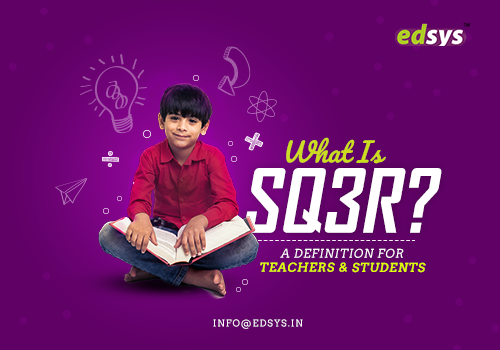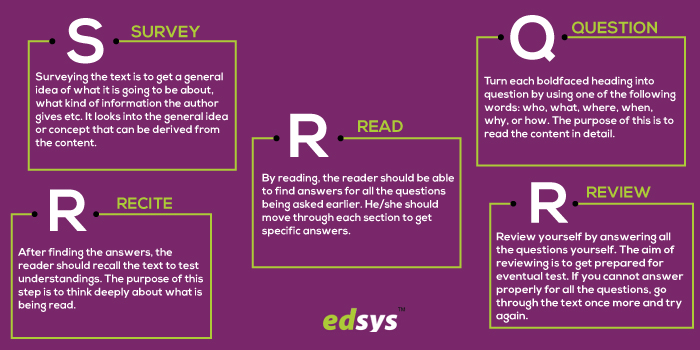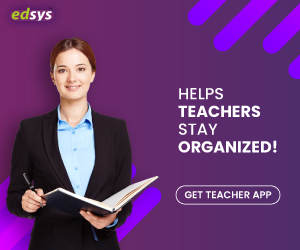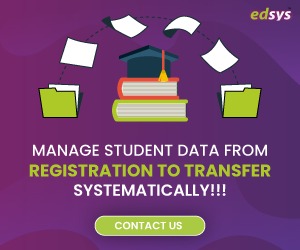Categories(658 Blogs)
Select Category
Watch Right Now
Teacher App - Class
Schedule & Attendance Management App
Parent App from Edsys

Best School Bus Tracking System

Cashless School - For Smart Schools of Tomorrow


What is SQ3R? A Definition for Teachers and Students

SQ3R is an amazing teaching and learning strategy designed to help students to improve the understanding and retention of what they have learned.
This is in fact a sequence that can be applied throughout the reading process to move from smaller to larger details and then back again.
Teachers use this strategy to get the better of teaching and learning by utilizing each stage of the reading course, say before, during and after.

SQ3R Definition
SQ3R is a step-by-step method to approach a text more efficiently for a better understanding.
This comprehensive method of teaching basically involves 5 steps –Survey, Question, Read, Recall and Review.
This helps students to be an effective reader as they learn to think about the topic or concept while they read. Let us have a look.
Survey
In this very first step, students are asked to simply skim or scan through the entire text book and look for pictures, headings, layouts, chapters, and sub headings.
Following which, they have to check out the summaries mentioned at the end of each chapter or book.
This gives them enough idea to foresee what the author is trying to convey and get an overview and structure. Notes can be taken based on the thoughts and have a look into the overall notes to get some idea.
- Catch up the title, headings, visuals, preview, bolded words & summary
- Think about background information or knowledge
They get an initial understanding of the concept through bolded texts, headings and charts which give a foundation for the active reading.
This step in fact gives a bigger picture of what is going to be learnt; and decide on what is necessary.
The present information can be connected or linked back to what is already known which help students to prepare for reading.
Question
In this second step, students are asked to convert the headings of paragraphs into meaningful questions. For example, if the heading is ‘importance of self discipline’, then, frame a question like ‘what is the importance of self discipline’ and then write it out.
- Turn headings into queries
- Try asking who, what, why and how
- Students can now stay focussed while reading
They learn to preview the content to generate questions out of it. Queries such as “What is this text about?” “What do I already know about the topic?” “What else I am missing?” etc can make reading time more productive. Having a purpose for reading in fact invokes interest and quizzing oneself on the subject is a great practice in learning.
Read
In the very next step, students have to read out the questions attentively and try to answer them.
They can actually answer the questions in their own words in notes. It is recommended to read the content areas that are complex or difficult, multiple times.
- Look out for solutions to the queries
- Highlight or underline key concepts
- Break up the comprehension into chunks
While reading, they will actually search for answers of the questions they had generated before during the preview.
This is a good practice to get relevant information from the textbook.
There is no better way to prepare for discussions and lectures. This even helps to become a master for test preparation.
Recall
Now students can close the text books and keep the notebooks away, and then try to recall what they have read in the book.
In fact they should try to mentally visualize the contents of the material, and try to recall the important highlights.
Also Read: Teacher App : A Complete Class Schedule and Attendance App
It is advised that more time needs to be spent for recalling rather than reading. It can either be done by explaining the content to someone else or by imagining the same.
- Say your answers aloud
- Note down summary of section or paragraph
- Identify main ideas of the topic
- Write note cards of relevant data
- Create a graphic organizer or mind map of how they relate
This is the phase when they rehearse the answers for their questions and prepare notes for later reference.
These are the best methods to retain or recall information after reading a topic and there is no better way to evaluate the level of understanding.
This even help students to stay awake and interact with reading.
Review
In the final phase of the strategy, students can take back the book and go through the notes, questions and answers to understand how well they have recalled.
Conclude the final phase by having a mental picture of the whole process.
- Quiz yourself on what has been learned
- Develop connections between notes and readings from class
- Revisit the topic at least once a week and give a test on old and new topics
They can review the text to reply to the queries previously answered. This is a great way to retain what has been learned on a weekly basis. Students can prepare for exams and assignments in a systematic way.
Teachers often mention about students who read a textbook fully and still have no idea about what exactly was covered.
This SQ3R strategy is a great solution for such students to improve their learning.
This method demands them to activate their thoughts throughout the reading process and review their understanding.
Moreover, the notes created during the reading can be later used as a study guide during exams
How Teachers Can Use The Strategy?
Applying this strategy in the most efficient way is important to experience the best results.
First of all, make students understand the importance of surveying, questioning, reading, reciting and reviewing to be an efficient reader.
The best way to implement this way of teaching is to model the five SQ3R steps.
- Choose a content area and model the strategy
- During each step of the SQ3R, don’t forget to explain the actual purpose like what and why they are doing so
- Following the session, ask students to independently perform the task while they read and practice SQ3R
- It can either be provided as a take home assignment or as a class session
- Following the session, let the students reassess their notes and reflect on the procedure.
This amazing reading method was first cited in the year 1946, in the book Effective Study”by Francis P. Robinson who was an American education psychologist.
Also Check: Latest Updated Educational Apps Directory List
All students need not find this method effective or feel an impact on the very first trial.
So it is highly important for the teachers to give them some time to get along with the method. Most importantly, teach them on how and when to apply the strategy.
The most important benefit of this strategy is to make optimum use of the reading time while discovering, understanding, and retaining the significant facts and ideas covered in the text.
Reviewing of information while they read the text can make a really good impact in remembering the essence of the text.
Once students feel an interest in the strategy, they will find reading and learning really simple and they will be surprised to score high in exams.
Recent Blogs
Our Educational Services
Popular Blogs
Subscribe

SUBSCRIBE TO OUR NEWSLETTER
Sign Up and Recieve the Latest News
Don’t Worry, We Don’t SpamExplore Our Extensive Researched Educational App Directory
Visit Now
















